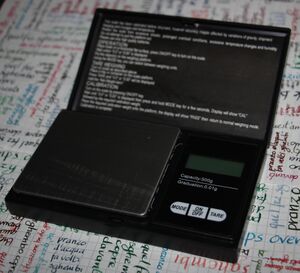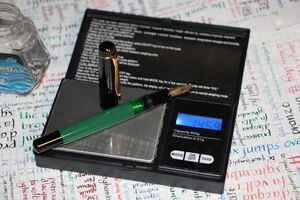Differenze tra le versioni di "Capacità dei sistemi di caricamento/en"
(Creata pagina con "Then the pen loaded with running water. For a comparison that takes into account the liquid remaining in the feeder, the weight was measured several times starting from the fi...") |
(Creata pagina con "The loading was carried out normally as you do when you load the ink for writing, removing the excess liquid from the feeder (shaking it slightly to drip and placing the nib n...") |
||
| Riga 29: | Riga 29: | ||
Then the pen loaded with running water. For a comparison that takes into account the liquid remaining in the feeder, the weight was measured several times starting from the first loading from the first empty and dry loading, repeating the loading and unloading cycles. | Then the pen loaded with running water. For a comparison that takes into account the liquid remaining in the feeder, the weight was measured several times starting from the first loading from the first empty and dry loading, repeating the loading and unloading cycles. | ||
| − | + | The loading was carried out normally as you do when you load the ink for writing, removing the excess liquid from the feeder (shaking it slightly to drip and placing the nib near the neck of the bottle) and drying the one that may be present on the section. An ordinary bottle of ink was used (Waterman 50 ml, but any one is fine, just soak the pen tip completely in it). | |
[[File:Esempio-Misura-Pelikan-481.jpg|thumb|An example of measurement]] | [[File:Esempio-Misura-Pelikan-481.jpg|thumb|An example of measurement]] | ||
Versione delle 16:51, 9 mag 2020
One of the criteria with which the filling system is chosen, especially in recent pens, is that of its capacity. It is also one of the criteria on the basis of which we most frequently take sensational dazzles, also because there is a widespread prejudice that a piston filler pen contains much more ink than a cartridge filler one, which, with pens on the market today, is almost never true.
The following table of cartridge capacity is used as a reference (the measures mentioned have been collected on the internet, and have not yet been verified with the methodology adopted later; when they will be, the relevant column will be updated):
| Brand | Type | Capacity | Verified |
|---|---|---|---|
| Pelikan | short | 0,77 ml | no |
| Parker | long | 1.47 ml | no |
| Sheaffer | slim | 1.20 ml | no |
| Sheaffer | standard | 1.50 ml | no |
| Internazional | long | 1.66 ml | no |
For this reason it was decided to start a collection of measures of the actual ink capacity of pens, but for a measure to qualify as such (and not be reduced to a simple statement), it must be repeatable, so in addition to the results of the same, the methodology used to obtain it must also be detailed.
The measurements have been carried out using a scale with sufficient precision, capable to appreciate the hundredth of a gram (of those for weighing gold and jewellery, that you can find for about ten euros on the internet). To give an idea of the order of magnitude, a drop of water from a dropper is between 2 and 4 centigrams.
First the pen was weighed completely empty, washed and left to dry completely so as to avoid any residue due to liquid remaining in the feeder. Left to dry completely means holding the pen upside down with the nib resting on a sheet of absorbent paper for at least a week, so as to exclude any residual water.
Then the pen loaded with running water. For a comparison that takes into account the liquid remaining in the feeder, the weight was measured several times starting from the first loading from the first empty and dry loading, repeating the loading and unloading cycles.
The loading was carried out normally as you do when you load the ink for writing, removing the excess liquid from the feeder (shaking it slightly to drip and placing the nib near the neck of the bottle) and drying the one that may be present on the section. An ordinary bottle of ink was used (Waterman 50 ml, but any one is fine, just soak the pen tip completely in it).
Si sono misurati più volte (almeno 10) sia il peso a penna carica, che a penna scaricata. Dalle varie misurazioni si è ottenuto il peso a penna carica e scarica calcolando media e deviazione standard. Non ha senso infatti utilizzare il valore più alto, il caricamento perfetto non esiste, quello che costituisce una indicazione di quanto nell'uso ordinario la penna carica davvero, è la media.
The value when the pen is discharged used to estimate how much liquid remains in the feeder, but we took as an indication of the filling capacity the value with the pen is fully filled, because pens are filled once the ink is finished and no longer reaches the nib, and this also includes the one present in the feeder. However, you can use the value with the pen empty for a fairer comparison with the capacity of the cartridges, as it indicates the capacity of the filling system alone (with cartridges the additional capacity of the ink held by the feeder when it is immersed to charge is not available).
The capacity in ml was then determined using the specific weight of the water which is 0,997 g/ml. The difference between tap water and pure water is below the appreciable limits of the measurement in centigrams, and inessential for the measurement whose accuracy is ±0.02 ml (sum of the systematic error of 0.01 g of the scale in the difference between two measurements, even if the error is always higher for a filled pen weight measurement), for the conversion, however, we can substantially assume an equivalence of 1 g => 1 ml being the difference below the measurement error.
Results
| Pen | Type | Empty | Filled | Unloaded | Capacity |
|---|---|---|---|---|---|
| Pelikan 140 | piston | 14,33 ± 0,01 g | 15,98 ± 0,04 g | 14,59 ± 0,03 g | 1.65 ± 0,05 ml |
| Duofold De Luxe | button | 22,10 ± 0,01 g | 24,00 ± 0,03 g | 22.35 ± 0,03 g | 1.90 ± 0,04 ml |
| Lamy 2000 ('60s) | piston | 20,88 ± 0,01 g | 22,68 ± 0,02 g | 21,59 ± 0,02 g | 1.80 ± 0,03 ml |
| Pelikan 481 | piston | 12,97 ± 0,01 g | 14,60 ± 0,01 g | 13,29 ± 0,01 g | 1,63 ± 0,01 ml |

